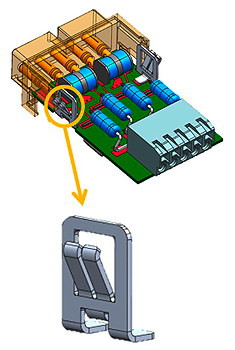- Home » News » Technology News
Surge protection in I/O connectors saves space and costs

Voltage transients in control circuits can have a devastating impact on plant operation. Even relatively small peaks can cause catastrophic damage to some electronic components.
To prevent such damage, control cabinet designers and builders normally use DIN-rail-mounted surge arresters to protect sensitive circuits. These typically consist of several I/O sensors and switches, each needing 6–12mm of DIN-rail mounting space. They require time and effort to install, adding to cabinet costs.
To tackle this issue, Harting has developed a new approach that saves control cabinet space and could lead to more cost-efficient, higher-density cabinet designs. The idea is to move the surge protection circuitry out of the cabinet and to integrate it into an I/O connector. This is achieved using a new surge-protection module that Harting has added to its Han-Modular family of connector inserts. This approach effectively stops potential overvoltage transients at the cabinet wall.
The surge protection module comes in two versions designed to protect digital and analogue I/O sensor circuits. The first safeguards devices such as inductive or ultrasonic proximity switches, while the second is aimed mainly at process sector applications. Both have built-in protective circuits developed by the surge protection specialist, Dehn+Sohne, to ensure failsafe operation, independent of the cause of failure in the surge protection module.
The transients, which can interrupt signal circuits and destroy electronic devices, are discharged to ground in the connector via a spring element that makes conductive contact with the earthed hinged frame that holds the modules in place.

Harting says that by integrating the surge protection modules into panel-mounted I/O connectors, control cabinets will become more flexible. Not only are transient voltage surges avoided in signal circuits, but if high-voltage transients – such as those caused by lightning strikes – occur, their EMI/RFI interference is prevented from being transmitted over the cabinet wiring, stopping it from reaching DIN-rail-mounted surge arresters and damaging sensitive electronic control circuits.
The module is thought to be the first of its type to be integrated into a panel-mounted sensor circuit I/O connector. Its modular design will also allow easy end-of-life replacement.





